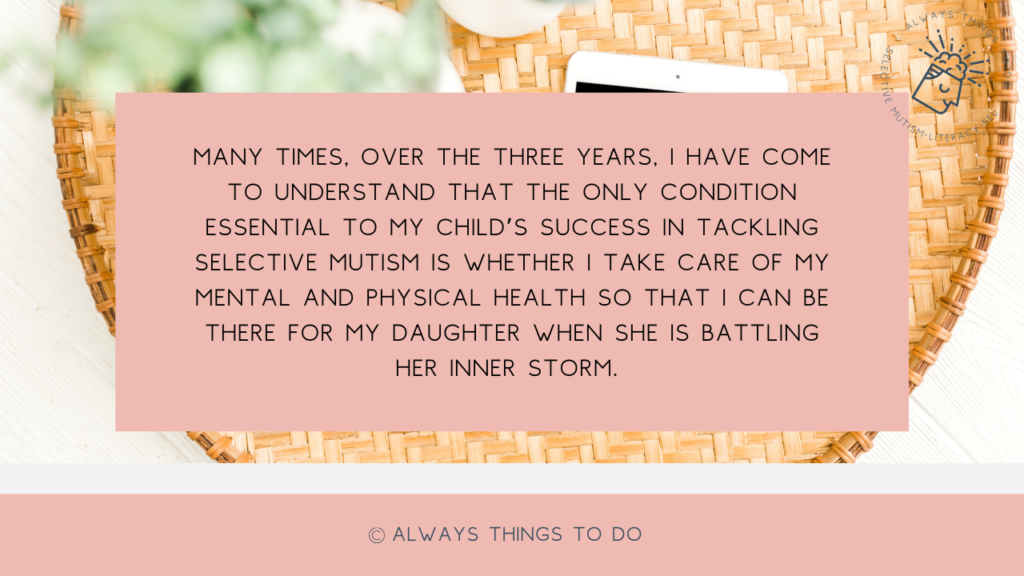Selective Mutism Myths: Most Common Concerns Addressed.

In this article, you will read about the 7 most common selective mutism myths.
1. Selective mutism will stay with my child forever.
It is the question that you and I and every parent mostly likely already asked, “Will selective mutism be there forever?”
The answer (that you probably know) is NO; it will NOT be there forever. Sigh…(I cried my first time hearing that answer; skeptical, fearful but hopeful). With the early diagnosis and appropriate treatment, MOST children can overcome selective mutism.
Yet, the battle with selective mutism is not only about the child affected. Like most families, my family, with all its members, has been affected by selective mutism and all the emotional turmoil it brings: tantrums, awkward moments, lonely evenings when it seems it will never end, “why-my-child?” moments, “how-can-we-be-just-a-normal-family!?” type of outcries.
For the child itself, the battle with selective mutism encompasses more than just overcoming anxiety to speak. It’s also social anxiety that often cripples a little one; it’s fear of not having friends, not being understood or valued, not being loved or heard.
Luckily, once everyone involved with the child’s education and family life is aware of the issues and has a plan to follow, treating selective mutism becomes a long but promising journey of tackling anxiety, behavior, and academic problems.
2. Selective mutism has to do with speech problems.
Even though selective mutism impacts a child’s ability to speak in many social settings, the issue with selective mutism does not lie in the speech itself.
Therefore, treating selective mutism is to target anxiety as the root cause of the child’s condition.
At the same time, it’s important to note that many children with selective mutism are often diagnosed with a particular speech disorder or have certain speech-related difficulties. Therefore, at school a child with an IEP might get speech classes, the goal of which is to fix the issues with intonation, pitch, some sounds, etc.
3. A child will eventually grow out of selective mutism.
Speaking of “growing out” of selective mutism is similar to saying someone will grow out of insomnia or depression.
Selective mutism is not part of growing up, nor should it be mixed with shyness.
Right before my child was diagnosed with selective mutism at 4, I used to describe her condition as shyness (even though it startled me) to the people outside of the family. The red flag appeared when, usually gregarious, sassy, and loud, my daughter had not talked to her teachers or peers for more than a month since she started her pre-school.
Apart from the not-speaking-problem, a child with selective mutism is often affected by other issues like mood swings, anger, irritability, academic struggles, fear of mistakes, loneliness, and some other sensory-related triggers.
Therefore, the treatment of selective mutism is never only about bringing a child back to speaking, it is, most importantly, the battle to provide the best environment for the child’s academic and social-emotional learning.
4. Selective mutism is a choice a child makes to show opposition and manipulation.
On the most challenging days of my life when selective mutism would show its ugliest side, and my daughter would scream, hit, be irritated by anyone and anything, cry loudly and curl into a ball of anger and despair, I often thought that her behavior was the consequence of my and my husband’s failure to be good parents.
But then, fighting the frustration and exhaustion, I would bring myself back to the understanding that my child is battling selective mutism, and, therefore, my goal was to help my child in this battle.
Please, remember that what might seem like opposition and manipulation (it can be challenging, I know …) is a child’s reaction to his/her anxiety and the multiple triggers it brings. Once this is clear, it’s much easier for a parent to see what needs to be done and give a child the calm and support he/she craves for.

5. Selective mutism is caused by abuse and trauma (parents’ fault).
The scariest and most excruciating characteristic that selective mutism bears for parents is that you tend to take the blame for everything that happens to your child.
One’s mind would continuously play the same tune until one believes in it, “I could have been a better mother, a happier mother to help my child. I could have spent more time with my child or gone on more trips…”
For about three years, I was convinced I was the culprit of my daughter’s condition. In some sessions with my child’s selective mutism therapist, I would ask whether I might have triggered my child’s anxiety.
My unhappiness with work, the overwhelm, and my inability to balance productively surely made me an anxious, tired mom, and it was often visible to my daughter.
What I want all the parents who read this to know is that you are NOT the reasons why your child has selective mutism. Even if you have or once had this thought in the back of your mind on your worst days, please, know that you can be a more powerful help to your child if you give up blaming yourself for the way your child is.
Many times, over the three years, I have come to understand that the only condition essential to my child’s success in tackling selective mutism is whether I take care of my mental and physical health so that I can be there for my daughter when she is battling her inner storm.
6. Selective mutism is autism.
Surprisingly, selective mutism and autism share many characteristics. In addition, selective mutism anxiety disorder is usually accompanied by many conditions that must be identified in order to provide the child with the proper treatment that addresses all of the difficulties the child may experience.
7. “To put my child on medication I must be a crazy parent”.
My child is currently taking medication.
Before we made this decision, I threw my own party of “how-low-you-have-fallen-mother”, cried until my head was buzzing, read tons of literature, talked to my child’s therapist, and argued with my husband.
I want to make it clear, that my family’s decision to start medication had NOTHING to do with her not speaking. Yes, you read it correctly.
“I just want her to be happy,” I confessed to the psychiatrist on our first day of evaluation before the medication for anxiety was prescribed. At this point, the selective mutism battle was NOT just about confronting selective mutism condition in a school, store, playground; it was about happiness, family’s happiness…
My daughter stopped going to the playground, turned more and more “depressive” and solemn, and would find every single opportunity to say that she was not loved or cared for.
I would, of course, feel guilty, apologize and give her thousands of hugs.
Still, at the end of the day, the deep insatiable, sole-eating hole of my child’s unhappiness would absorb us all, and we all would feel shattered, guilty, shaken, and silent because we all failed at something.
Long story short, the purpose of medication for my child was to tackle the growing and crippling anxiety and its effects on her mood, happiness, and psychological and physical well-being.
Now I can say, I have NEVER EVER been HAPPIER in my life, and so has my child.
The bottom line, the decision about medication is a hard one. It can only be taken after the consideration of many factors, such as conversation with your SM treatment therapist, your observation of your own child, and most importantly, evaluation by the licensed psychiatrist.
If you liked the information in this post, make sure you explore other posts about selective mutism:
- “What Is Selective Mutism?”
- “Selective Mutism: How To Beat Crisis, Screaming, and Fear.”
- Diagnosis of Selective Mutism: Simple Parent Guide and Steps to Take.
- What Are The Causes of Selective Mutism?
- Is Selective Mutism a Disability?
- How Do You Treat Selective Mutism?
- 70 Selective Mutsim Symptoms & 3 Diagnostic Criteria.
Check out the expanding library of tools. Go to the selective mutism page and scroll to the bottom section, “Latest Projects.”
Connect with me on social media @alwaysthingstodo.



One Comment
Pingback: